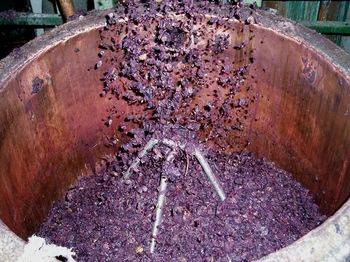Wine Pomace
Wine Pomace is the by-product obtained during the manufacture of wine and grape juice. It constitutes a set of dry residues which can have different uses, in particular in herbal medicine. Today, Wine Pomace is particularly popular in cosmetics and herbal medicine. It is thus used in the composition of several topical products such as creams and gels, but also in the formulation of food supplements. These are usually in the form of capsules. However, when the grape marc is combined with other plant extracts or other active ingredients, the supplements can be packaged in other formats such as tablets or ampoules.
See also :
Contents
Compounds
It concentrates in fact many active ingredients from grapes including a wide variety of polyphenols, compounds known for their powerful antioxidant power. Grape marc is also known for its slimming and anti-cellulite action. Wine Pomace has aroused great interest in herbal medicine because of its composition in active ingredients. It concentrates indeed many compounds, among which are:
- anthocyanins
- flavonoids including catechins and flavonols
- phenolic acids such as hydroxycinnamic acid and gallic acid
- stilbenes including trans-resveratrol
- tannins
- fibers
Special Precautions of Wine Pomace
- Contraindications: Grape marc is a natural product that is well tolerated by the body. However, as a precautionary measure and before starting a cure, it is advisable to seek medical advice from pregnant women, breastfeeding women and people undergoing medical treatment.
- Side effects: To date, no major side effects have been recorded during the use of products based on grape marc.
Health Benefits and Uses of Wine Pomace
- Antioxidant power : The phenolic compounds in grape pomace, such as flavonoids and tannins, exhibit strong antioxidant capacity. This helps to fight against the accumulation of hyper-reactive oxidizing species, a phenomenon known under the name of oxidative stress and to be at the origin of numerous cellular damages. Several studies have shown that the antioxidant substances in grape pomace help inactivate free radicals attacking lipids or even prevent the breakdown of certain molecules (eg hydroperoxides) into free radicals.
- Anti-aging potential : The antioxidant power of grape marc gives it anti-aging effects. Indeed, oxidative stress is known to be involved in the premature aging of the body.
- Draining, anti-cellulite and slimming action : Studies carried out on grape marc have shown that it can act as a natural drainer. Positive results have been observed in particular to fight cellulite, refine the silhouette and contribute to weight loss.
- Lipid-lowering activity : In addition to its slimming effects, grape marc also seems to help improve the lipid profile. Studies show that it can indeed help lower blood lipid levels, including cholesterol. Studies are currently underway to assess the benefits of this lipid-lowering action on health, particularly in the heart.
- Benefits for blood circulation : Grape marc is often recommended for heavy legs sensations. Indeed, its compounds have been shown to be effective in improving blood circulation.
- Anti-inflammatory activity : Several studies also suggest that the polyphenols present in grape pomace have anti-inflammatory activity. This could be of interest in the management of certain inflammatory conditions such as colitis. Further studies are in progress.
- Other benefits under study : The compounds in grape pomace could have many secrets to reveal. In any case, this is what the many studies carried out in recent years suggest. It would seem in particular that the grape pomace can have antibacterial and antifungal properties. In addition to its lipid-lowering action, it could also have an interest in the fight against other metabolic disorders.
Main Combinations
- Cellulite :
- Wine Pomace + Pineapple + Meadowsweet + Birch + Green Coffee
- Green Coffee + Pineapple + Wine Pomace
- Overweight with Circulatory Problems : Green Tea + Hamamelis + Pilosella officinarum + Wine Pomace
